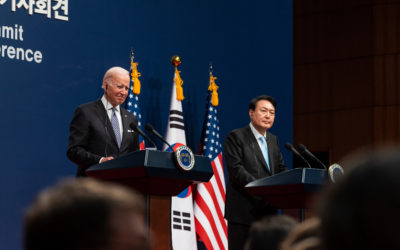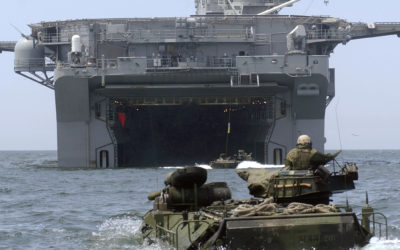On April 26, U.S. President Joe Biden welcomed South Korean President Yoon Suk-yeol to the White House for a summit meeting to celebrate the seventieth anniversary of the U.S.-South Korea alliance and open a new chapter for the next seventy years of expanded cooperation. Amid a substantial list of topics discussed by the two leaders, extended deterrence emerged as the top deliverable.
High Cost of Taiwan Invasion Will Dissuade China, Pentagon Official Says
High Cost of Taiwan Invasion Will Dissuade China, Pentagon Official Says
High Cost of Taiwan Invasion Will Dissuade China, Pentagon Official Says
China will not attempt to invade Taiwan before the end of the decade because it understands the high cost, the senior Pentagon official in charge of Indo-Pacific security said Thursday.
“Deterrence is real; deterrence is strong” today and tomorrow, said Ely Ratner, the assistant secretary for the Indo-Pacific. The United States can likely deter Beijing from attacking the self-governing island 100 miles off the Chinese coast, he said.
Speaking at a Hudson Institute event Thursday, Ratner cited the administration’s position that the Peoples Republic of China “is the only country with the capability and intent to overthrow the international order.”
But in the past year, Washington, its allies and partners have built-up capabilities to “ensure that kind of coercion and bullying” – from threats of attack to interfering with transiting aircraft and shipping – doesn’t succeed, he said.
Ratner termed what’s happening regionally “as a breakthrough year for alliances and partnerships” in countering China’s military and territorial ambitions. He pointed to Japan’s decision to ramp up defense spending and work on counter-strike weapons, the agreement between the U.S. and the Philippines on establishing four new sites in the island republic for U.S. forces and the progress on the technology sharing agreement between Australia, the United Kingdom and the U.S.
He also cited the “new technology dialogue” with India that will lead to more co-development and co-production activities “that make our defense industrial bases more compatible.”
Ratner’s comments come after Undersecretary of Defense for Policy Colin Kahl testified before the House Armed Services Committee this week that he does not think China will attempt to invade Taiwan before 2027.
Secretary of Defense Lloyd Austin also does not see an imminent Chinese threat to Taiwan, Pentagon Press Secretary Brig. Gen. Patrick Ryder said Thursday during a press briefing.
Because of the threats from China and North Korea, the U.S. is increasing the number of exercises it conducts in the region. The Marine Corps’ Marine Littoral Regiment formation and the Navy’s distributed forces will be key to increasing regional security and cooperation, he said. Ratner also mentioned steps the U.S. Army has taken to update its mission in the Indo-Pacific and the Air Force’s search for dispersed bases for its operations.
In the near future, Rattner said “you’ll see more capability flowing into the region” from the United States and its allies and partners.
Lindsey Ford, deputy assistant secretary of defense for South and Southeast Asia, mentioned the Indo-Pacific Maritime Domain Awareness Initiative as a way to create a common operating picture for all participants as a starting point on new capabilities that benefit many nations.
Sparked by the May 2022 summit meeting between the leaders of the U.S., Japan, Australia and India, the initiative uses off the shelf hardware and software to provide real-time data from satellites, according to a White House fact sheet on the effort. This extends to ships that have turned off their Automatic Identification Systems (AIS) to hide their illegal fishing, smuggling or drugs and arms trafficking.
Ford said that through the initiative, real-time data on these activities can “be shared multilaterally,” not just by two nations.
“This is exactly the kind of work the Quad should be doing,” she said, referring to the informal security relationship between the U.S., Japan, Australia and India.
This initiative that is now underway in the waters of Southeast Asia and will soon expand to the Pacific Islands, Defense Daily reported last year.
The initiative gives countries that don’t want to be forced to make a choice between the United States and China “the space” to “decide their own interests and choices,” Ratner said.
When asked about the rising number of provocative incidents involving PLA aircraft and military aircraft from allies operating in international airspace, Ratner said, “they’re not picking a fight” to start a conflict. But, he added, “we will not be coerced and bullied” by these incidents. “We will sail, fly and operate” in international waters and air space.
“That is the message privately and publicly” to the Chinese government, Ratner added.
But when Beijing doesn’t want to hear the complaint, “they will turn off” all lines of communication “for an extended period of time,” as they did when the U.S. military show down China’s spy balloon off the South Carolina coast last month.
“This was a surveillance balloon, period. It was part of a broader fleet of capabilities that have flown over 40 countries and five continents,” Ratner said. Military and intelligence analysts are examining the salvage remnants.
“We think [turning off communications after an incident] is destabilizing and dangerous,” he added.
Using another tactic to deflect responsibility, Ford said the Chinese often decry incidents like Philippine fishermen discovering rocket debris in Philippine territorial water as “fake news.”
In response to North Korea’s escalating missile tests, Ratner said the U.S. and South Korea are working more closely together and exercising together so Seoul “will know what our thinking would be” if there is an attack.
“We’re focused on readiness.” That way, “you do [deterrence] with a sense of confidence,” he said.
Republished from the U.S. Naval Institute under a Creative Commons license to point Indo-Pacific warfighters and national security professionals to reputable war studies literature. Read the original article.

John Grady, a former managing editor of Navy Times, retired as director of communications for the Association of the United States Army. His reporting on national defense and national security has appeared on Breaking Defense, GovExec.com, NextGov.com, DefenseOne.com, Government Executive and USNI News.
Related Articles
President Marcos Jr. Meets With President Biden—But the U.S. Position in Southeast Asia is Increasingly Shaky
Over a four-day visit to Washington, Philippine President Ferdinand Marcos Jr. has been welcomed to the White House and generally feted across Washington. With President Biden, Marcos Jr. (whose father was forced out of office in part through U.S. pressure, and whose family has little love for the United States) affirmed that the two countries are facing new challenges, and Biden said that “I couldn’t think of a better partner to have than [Marcos Jr.].”
The U.S. is about to blow up a fake warship in the South China Sea—but naval rivalry with Beijing is very real and growing
As part of a joint military exercise with the Philippines, the U.S. Navy is slated to sink a mock warship on April 26, 2023, in the South China Sea.
The live-fire drill is not a response to increased tensions with China over Taiwan, both the U.S. and the Philippines have stressed. But, either way, Beijing isn’t happy – responding by holding its own staged military event involving actual warships and fighter jets deployed around Taiwan, a self-governed island that Beijing claims as its own.



